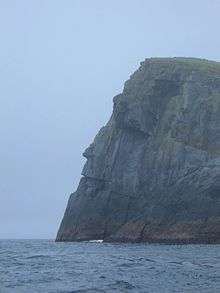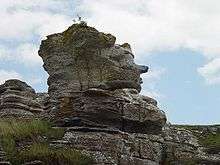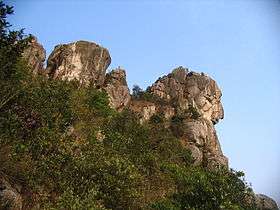Pareidolia

Pareidolia (/pærɪˈdoʊliə/ parr-i-DOH-lee-ə) is a psychological phenomenon in which the mind responds to a stimulus, usually an image or a sound, by perceiving a familiar pattern where none exists.
Common examples are perceived images of animals, faces, or objects in cloud formations, the Man in the Moon, the Moon rabbit, hidden messages in recorded music played in reverse or at higher- or lower-than-normal speeds, and hearing indistinct voices in random noise such as that produced by air conditioners or fans.[1]
Etymology
The word derives from the Greek words para (παρά, "beside, alongside, instead [of]" — in this context meaning something faulty or wrong) and the noun eidōlon (εἴδωλον "image, form, shape" — the diminutive of eidos).
Explanations

Pareidolia can cause people to interpret random images, or patterns of light and shadow, as faces.[2] A 2009 magnetoencephalography study found that objects perceived as faces evoke an early (165 ms) activation of the fusiform face area at a time and location similar to that evoked by faces, whereas other common objects do not evoke such activation. This activation is similar to a slightly faster time (130 ms) that is seen for images of real faces. The authors suggest that face perception evoked by face-like objects is a relatively early process, and not a late cognitive reinterpretation phenomenon.[3] A functional magnetic resonance imaging (fMRI) study in 2011 similarly showed that repeated presentation of novel visual shapes that were interpreted as meaningful led to decreased fMRI responses for real objects. These results indicate that the interpretation of ambiguous stimuli depends upon processes similar to those elicited by known objects.[4]
These studies help to explain why people identify a few circles and a line as a "face" so quickly and without hesitation. Cognitive processes are activated by the "face-like" object, which alert the observer to both the emotional state and identity of the subject, even before the conscious mind begins to process or even receive the information. A "stick figure face", despite its simplicity, can convey mood information, and be drawn to indicate emotions such as happiness or anger. This robust and subtle capability is hypothesized to be the result of eons of natural selection favoring people most able to quickly identify the mental state, for example, of threatening people, thus providing the individual an opportunity to flee or attack pre-emptively. In other words, processing this information subcortically — therefore subconsciously — before it is passed on to the rest of the brain for detailed processing accelerates judgment and decision making when a fast reaction is needed.[5] This ability, though highly specialized for the processing and recognition of human emotions, also functions to determine the demeanor of wildlife.[6]
Pareidolia can be considered a subcategory of Apophenia.
Mimetoliths
Rocks may come to mimic recognizable forms through the random processes of formation, weathering and erosion. Most often, the size scale of the rock is larger than the object it resembles, such as a cliff profile resembling a human face. Well-meaning people with a new interest in fossils can pick up chert nodules, concretions or pebbles resembling bones, skulls, turtle shells, dinosaur eggs, etc., in both size and shape.
In the late 1970s and early 1980s, Japanese researcher Chonosuke Okamura self-published a series of reports titled Original Report of the Okamura Fossil Laboratory, in which he described tiny inclusions in polished limestone from the Silurian period (425 mya) as being preserved fossil remains of tiny humans, gorillas, dogs, dragons, dinosaurs and other organisms, all of them only millimeters long, leading him to claim, "There have been no changes in the bodies of mankind since the Silurian period... except for a growth in stature from 3.5 mm to 1,700 mm."[7][8] Okamura's research earned him an Ig Nobel Prize (a parody of the Nobel Prizes) in biodiversity in 1996.[9][10]
Projective tests
The Rorschach inkblot test uses pareidolia in an attempt to gain insight into a person's mental state. The Rorschach is a projective test, as it intentionally elicits the thoughts or feelings of respondents that are "projected" onto the ambiguous inkblot images.[11]
Art

In his notebooks, Leonardo da Vinci wrote of pareidolia as a device for painters, writing, "If you look at any walls spotted with various stains or with a mixture of different kinds of stones, if you are about to invent some scene you will be able to see in it a resemblance to various different landscapes adorned with mountains, rivers, rocks, trees, plains, wide valleys, and various groups of hills. You will also be able to see divers combats and figures in quick movement, and strange expressions of faces, and outlandish costumes, and an infinite number of things which you can then reduce into separate and well conceived forms."[12]
Architecture
Two 13th century edifices in Turkey display architectural use of shadows of stone carvings at the entrance. Outright pictures are avoided in Islam but tessellations and calligraphic pictures were allowed, so "accidental" silhouettes became a creative escape.
- Alaaddin Mosque, Niğde, Turkey (1223) with its "mukarnas" art where the shadows of three-dimensional ornamentation with stone masonry around the entrance form a chiaroscuro drawing of a woman's face with a crown and long hair appearing at a specific time, at some specific days of the year.[13][14][15]
- Divriği Great Mosque and Hospital in Sivas, Turkey (1229) shows shadows of the 3 dimensional ornaments of both entrances of the mosque part, to cast a giant shadow of a praying man that changes pose as the sun moves, as if to illustrate what the purpose of the building is. Another detail is the difference in the impressions of the clothing of the two shadow-men indicating two different styles, possibly to tell who is to enter through which door.[16]
Religious
There have been many instances of perceptions of religious imagery and themes, especially the faces of religious figures, in ordinary phenomena. Many involve images of Jesus,[11] the Virgin Mary,[17] the word Allah,[18] or other religious phenomena: in September 2007 in Singapore, for example, a callus on a tree resembled a monkey, leading believers to pay homage to the "Monkey god" (either Sun Wukong or Hanuman) in the monkey tree phenomenon.[19]
Publicity surrounding sightings of religious figures and other surprising images in ordinary objects has spawned a market for such items on online auctions like eBay. One famous instance was a grilled cheese sandwich with the face of the Virgin Mary.[20]
Computer vision
.jpg)
Pareidolia also arises in computer vision,[21] specifically in image recognition programs, which can spuriously detect features. In the case of an artificial neural network, higher-level features correspond to more recognizable features, and enhancing these features brings out what the computer sees. These reflect the training set of images that the network has "seen" previously.
Striking visuals can be produced in this way, notably in the DeepDream software, which falsely detects and then exaggerates features such as eyes and faces in any image.
Speech
In 1971 Konstantīns Raudive wrote Breakthrough, detailing what he believed was the discovery of electronic voice phenomena (EVP). EVP has been described as auditory pareidolia.[11] Allegations of backmasking in popular music, in which a listener claims a message has been recorded backward onto a track meant to be played forward, have also been described as auditory pareidolia.[11][22] In 1995, the psychologist Diana Deutsch invented an algorithm for producing phantom words and phrases with the sounds coming from two stereo loudspeakers, with one to the listener's left and the other to his right. Each loudspeaker produces a phrase consisting of two words or syllables. The same sequence is presented repeatedly through both loudspeakers; however, they are offset in time so that when the first sound (word or syllable) is coming from the speaker on the left, the second sound is coming from the speaker on the right, and vice versa. After listening for a while, phantom words and phrases suddenly emerge, and these often appear to reflect what is on the listener's mind, and they transform perceptually into different words and phrases as the sequence continues.[23][24]
Related phenomena
Various European ancient divination practices involved the interpretation of shadows cast by objects. For example, in molybdomancy, a random shape produced by pouring molten tin into cold water is interpreted by the shadow it casts in candlelight.
A shadow person (also known as a shadow figure, shadow being or black mass) is often attributed to pareidolia. It is the perception of a patch of shadow as a living, humanoid figure, particularly as interpreted by believers in the paranormal or supernatural as the presence of a spirit or other entity.[25]
Pareidolia is also what some skeptics believe causes people to believe that they have seen ghosts.[26]
Notable examples
 The Romanian Sphinx in Bucegi Mountains
The Romanian Sphinx in Bucegi Mountains Human face on Pedra da Gavea in Rio de Janeiro, Brazil, known as the "Head of the Emperor"
Human face on Pedra da Gavea in Rio de Janeiro, Brazil, known as the "Head of the Emperor"
 The "Grimacing human face" of red shale (Cians, Mercantour National Park)
The "Grimacing human face" of red shale (Cians, Mercantour National Park)


- "Elephant Rock" on Heimaey, Iceland


.jpg) Father Trebeurden Trébeurden in Côtes-d'Armor, France
Father Trebeurden Trébeurden in Côtes-d'Armor, France

 Lion Rock at the peak of Lion Rock Hill in Hong Kong
Lion Rock at the peak of Lion Rock Hill in Hong Kong
See also
References
- ↑ Jaekel, Philip. "Why we hear voices in random noise". Nautilus. Retrieved April 1, 2017.
- ↑ Sagan, Carl (1995). The Demon-Haunted World – Science as a Candle in the Dark. New York: Random House. ISBN 0-394-53512-X.
- ↑ Hadjikhani, Nouchine; Kveraga, Kestutis; Naik, Paulami; Ahlfors, Seppo P. (2009). "Early (M170) activation of face-specific cortex by face-like objects". NeuroReport. 20 (4): 403–7. doi:10.1097/WNR.0b013e328325a8e1. PMC 2713437. PMID 19218867.
- ↑ Voss, J. L.; Federmeier, K. D.; Paller, K. A. (2012). "The Potato Chip Really Does Look Like Elvis! Neural Hallmarks of Conceptual Processing Associated with Finding Novel Shapes Subjectively Meaningful". Cerebral Cortex. 22 (10): 2354–64. doi:10.1093/cercor/bhr315. PMC 3432238. PMID 22079921.
- ↑ Svoboda, Elizabeth (2007-02-13). "Facial Recognition – Brain – Faces, Faces Everywhere". The New York Times. The New York Times. Retrieved July 3, 2010.
- ↑ "Dog Tips – Emotions in Canines and Humans". Partnership for Animal Welfare. Retrieved July 3, 2010.
- ↑ Spamer, E. "Chonosuke Okamura, Visionary". Philadelphia: Academy of Natural Sciences. archived at Improbable Research.
- ↑ Berenbaum, May (2009). The earwig's tail: a modern bestiary of multi-legged legends. Harvard University Press. pp. 72–73. ISBN 0-674-03540-2.
- ↑ Abrahams, Marc (2004-03-16). "Tiny tall tales: Marc Abrahams uncovers the minute, but astonishing, evidence of our fossilised past". The Guardian. London.
- ↑ Conner, Susan; Kitchen, Linda (2002). Science's most wanted: the top 10 book of outrageous innovators, deadly disasters, and shocking discoveries. Most Wanted. Brassey's. p. 93. ISBN 1-57488-481-6.
- 1 2 3 4 Zusne, Leonard; Jones, Warren H (1989). Anomalistic Psychology: A Study of Magical Thinking. Lawrence Erlbaum Associates. pp. 77–79. ISBN 0-8058-0508-7. Retrieved 2007-04-06.
- ↑ Da Vinci, Leonardo (1923). John, R; Don Read, J, eds. "Note-Books Arranged And Rendered Into English". Empire State Book Co.
- ↑ Niğde Alaaddin Camii ’nin Kapısındaki Kadın Silüetinin Sırrı?
- ↑ Camiler, ALÂEDDİN CAMİ
- ↑ HISTORICAL MONUMENTS OF NIGDE
- ↑ DİVRİĞİ ULU CAMİİ'NDE 'NAMAZ KILAN İNSAN' SİLÜETİ
- ↑ "In New Jersey, a Knot in a Tree Trunk Draws the Faithful and the Skeptical", The New York Times, July 23, 2012 .
- ↑ Ibrahim, Yahaya (2011-01-02). "In Maiduguri, a tree with engraved name of God turns spot to a Mecca of sorts". Sunday Trust. Media Trust Limited, Abuja. Archived from the original on 2012-11-04. Retrieved 2012-03-21.
- ↑ Ng, Hui Hui (13 September 2007). "Monkey See, Monkey Do?". The New Paper. pp. 12–13. Archived from the original on 2007-10-14.
- ↑ "'Virgin Mary' toast fetches $28,000". BBC News. 23 November 2004. Retrieved 2006-10-27.
- ↑ Chalup, Stephan K., Kenny Hong, and Michael J. Ostwald. "Simulating pareidolia of faces for architectural image analysis." brain 26.91 (2010): 100.
- ↑ Vokey, John R.; Read, J. Don (1985). "Subliminal messages: Between the devil and the media". American Psychologist. 40 (11): 1231–9. doi:10.1037/0003-066X.40.11.1231. PMID 4083611.
- ↑ Deutsch, D. (1995). "Musical Illusions and Paradoxes". Philomel Records.
- ↑ Deutsch, D. (2003). "Phantom Words and Other Curiosities". Philomel Records.
- ↑ Ahlquist, Diane (2007). The Complete Idiot's Guide to Life After Death. USA: Penguin Group. p. 122. ISBN 978-1-59257-651-7.
- ↑ Carroll, Robert Todd (June 2001). "pareidolia". skepdic.com. Retrieved 2007-09-19.
- ↑ Speigel, Lee (October 19, 2015). "Buddha Statue (Or Rock Formation) Spotted On Mars". The Huffington Post. Retrieved December 12, 2015.
External links
| Wikimedia Commons has media related to Pareidolias. |
| Look up pareidolia in Wiktionary, the free dictionary. |
- Skepdic.com Skeptic's Dictionary definition of pareidolia
- Article in The New York Times, 13 February 2007, about cognitive science of face recognition